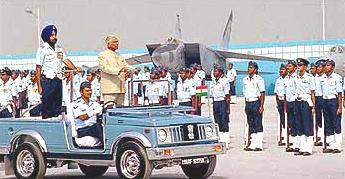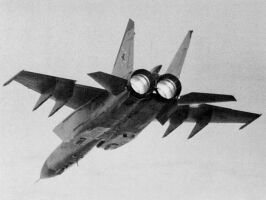
VayuSena
Air Power International
By Peter Steinemann
Last May (1997), an Indian Force (IAF) Mikoyan MiG-25RB Foxbat-B reconnaissance aircraft created a furore when the pilot flew faster than Mach 2 over Pakistani territory following a reconnaissance mission into Pakistan airspace. The Foxbat broke the sound barrier while flying at an altitude of around 65,000 feet, otherwise the mission would have remained covert, at least to the general public. The Pakistan Government considered the breaking of the sound barrier as deliberate: to make the point that the Pakistan Air Force (PAF) has no aircraft in its inventory which can come close to the cruising height of the MiG-25 (up to 74,000 feet).
However, from one of PAF's Forward Operating Bases, radar traced the intruder and the F-16As scrambled. Sources in the PAF said that there was no need to intercept a plane flying at the altitude of 65,000 feet as the F-16 can reach an operating ceiling of 55,000 feet.
India denied the incident but Pakistan's Foreign Minister, Gohar Ayub Khan, believed that the Foxbat photographed strategic installations near the Capital, Islamabad. Interestingly, the two countries signed a 'Prevention of Air Space Violations' agreement in April 1991, which recognized that PAF and IAF aircraft operate near each other's airspace. The agreement permitted overflights and landings by military aircraft, but certainly not airborne reconnaissance.

With tensions running high between Pakistan and India, there have been the inevitable comparisons of relative strengths and weaknesses of the two sides and discussion of possible scenarios in the event of armed hostilities. The general consensus is that while India has superiority in both manpower and arms in a strictly numerical order-of-battle assessment, it has certain key weaknesses that would make it difficult, perhaps impossible, for India to win a quick and decisive victory.
In terms of air power, India has a 2:1 advantage with an estimated 900 combat aircraft to Pakistan's 450, and this is even greater when viewed in qualitative terms. The IAF has re-equipped its combat inventory in the past decade with: Dassault Mirage 2000s, MiG-29s and Sukhoi Su-30s for air defence, MiG-23s for tactical air support, SEPECAT Jaguars for the deep penetration strike role, and MiG-25s for strategic reconnaissance.
On the other side, the PAF's acquisitions have been limited to three squadrons of General Dynamics (now Lockheed Martin) F-16A/B fighters and Chinese F-7P Skybolt day fighters to supplement its 100 Mirage IIIs and 5s and Chinese A-5s. Six MiG-25RB Foxbat-B high-altitude supersonic reconnaissance aircraft were delivered to India in 1981 together with two MiG-25RU Foxbat-C two-seater conversion trainers, forming No. 102 'Trisonic' Squadron at Barelli.
The MiG-25 design was already over 20 years old in 1981, originating in the late 50s as a response to the ambitious Lockheed YF-12A development. Referred to inside the OKB as the Ye-155P-1 (P for Perekhvatchik or Interceptor), the prototype was powered by two Mikulin-Tumansky R-15B-300 turbojets (rated at 10,210 kg thrust with afterburner with a service life of only 150 hours). It's first flight was in September.

RAW POWER: MiG-25 with afterburners engaged
To achive Mach 3 requires not only powerful engines, but the airframe also has to withstand the heat barrier wit airflow temperatures of up to 300 degrees Celsius. The aircraft structure was therefore made of welded steel and skinned partly with titanium and D19 duralumin, which was revealed for the first time to the West when Victor Belenko defected with his MiG-25P to Japan, landing at Hakodate Airport in September 1976.
Mass production of the MiG-25P Foxbat-A interceptor commenced in 1969 but the type didn't enter service with the Soviet Air Force until 1973, to be followed by the improved MiG-25PD in 1978. The Tumansky engineers also managed to extend engine service life in stages to 1000 hours.
With the MiG-25's impressive operational envelope, the obvious step was to develop the type into a high-altitude supersonic reconnaissance aircraft. It was designed and built in 1961 to 1962 as the Ye-155R-1. The prototype was first flown in March 1964, powered by the same Tumansky R-15BD-300 engine type fitted to the MiG-25P.
The Ye-155R-1 engine entered into production in 1969 at the Gorki factory as the MiG-25R Foxbat-B, followed one year later by the MiG-25RB, giving the type a bombing capability. All MiG-25Rs already built were upgraded with retrofit kits to the standard of the MiG-25RB reconnaissance/bomber variant, which was further developed in several specialized subtypes.
The MiG-25RB has no defensive armament but relies on its Mach 3 speed and operating ceiling of above 70,000 feet to escape any attacker. Two left-to-right rotating cameras of a focal length of 650 mm and/or 13000 mm can be fitted in the three interchangeable camera bays located in the nose cone of the aircraft. The two cameras shoot through two port and two starboard windows, and a vertical camera with a shorter focal length is located under the cockpit to make the horizon-to-horizon shots.
The aircraft is also equipped with a number of electromagnetic-spectrum sensors along with a larger and more capable side-looking airborne radar (SLAR). The MiG-25RB can also carry up to six 500 kg bombs, four under the wings and two under the fuselage. With a length of over 22 metres, the MiG-25 is as long as a Fokker F-27 Friendship.
As the MiG-25 represented an entirely new performance envelope for combat pilots, a dedicated conversion trainer was developed. Named MiG-25U, which first flew in 1973 and entered service soon after, it differed from the standard MiG-25 variants in having a totally redesigned forward fuselage component containing two seperate cockpits. The type has no SLAR nor any reconnaissance capability and is solely used for conversion training. Algeria, Bulgaria, Iraq and Syria were other export customers of the MiG-25RB, and more than 700 MiG-25 of all variants had been built when production came to an end in late 1984.

Comments or Questions? Contact Us
[Home] [The IAF Today] [Other Ops & Incidents] [Kargil 1999] [1980s] [1971] [1965] |
© Air Power International |
Top |